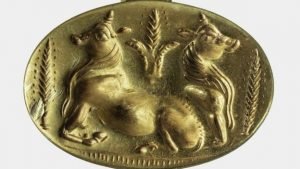Mycenaean Tombs Uncovered
 Two high-status Mycenaean-era tombs have been discovered in the Peloponnese, which belongs to a period known as Late Helladic IIA, which lasted from 1,600 to 1,500 B.C.
Two high-status Mycenaean-era tombs have been discovered in the Peloponnese, which belongs to a period known as Late Helladic IIA, which lasted from 1,600 to 1,500 B.C.
The more than 3,500-year-old graves contained many gold artefacts including a gold ring engraved with bulls flanked by sheaves of barley (below), a pendant depicting the Egyptian goddess Hathor, a protector of the dead (above), armour, weapons, an agate sealstone depicting two warriors fighting and beads made of amber, carnelian and malachite.
The tombs were also littered with tiny pieces of gold leaf that had once lined the walls.
The larger of the two tombs is 39 feet in diameter and the smaller is 28 feet. Both were originally built in a beehive shape known as a “tholos”, but the roofs had collapsed in antiquity helping to protect the finds from looters.
The site is near the Bronze Age palace of Pylos, in the southern Peloponnese region.
These items suggest that Pylos, a city with a fine port, had previously unknown trading connections with Egypt and the Near East around 1500 B.C.E.


